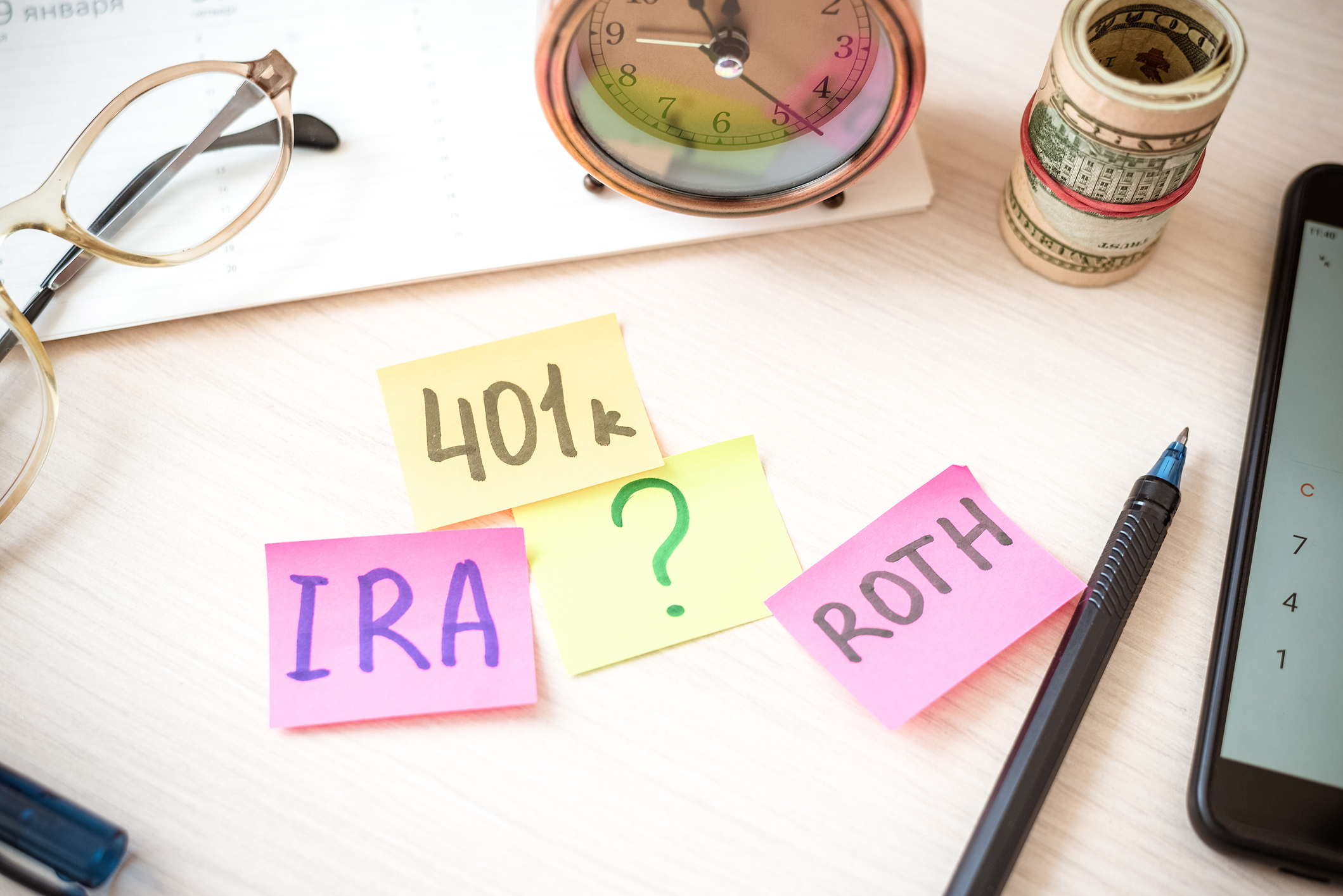How to Roll Over a 401(k) in Five Steps
Here's how to roll over a 401(k) to a traditional IRA, Roth IRA or Roth 401(k).

Kathryn Pomroy

The decision to roll over a 401(k) — financial-speak for moving money into another retirement account — should not be taken lightly. What you do with a 401(k) from a former employer can have major tax consequences today and in retirement. You should carefully plan out your rollover strategy to get the biggest retirement reward.
Rollovers are popular: The most recent data from the IRS states that approximately 6.1 million taxpayers rolled over about $727 billion in eligible distributions from qualified retirement plans like 401(k)s in tax year 2021. One reason is just for simplification. Imagine yourself, retired, looking at three or even four 401(k) plans from past employers and trying to devise a withdrawal strategy that meets your retirement income needs. Then, imagine the burden of tracking taxes on multiple traditional 401(k) account withdrawals. That's a hard pass!
You can consolidate those accounts by rolling over your 401(k)s. If you suspect your tax bracket will be higher during retirement, you can roll a 401(k) into a Roth IRA or Roth 401(k). These are just some of the advantages of rollovers.
From just $107.88 $24.99 for Kiplinger Personal Finance
Become a smarter, better informed investor. Subscribe from just $107.88 $24.99, plus get up to 4 Special Issues

Sign up for Kiplinger’s Free Newsletters
Profit and prosper with the best of expert advice on investing, taxes, retirement, personal finance and more - straight to your e-mail.
Profit and prosper with the best of expert advice - straight to your e-mail.
How to roll over a 401(k) in five steps
A 401(k) rollover occurs when you move funds from an old 401(k) to a new 401(k) or individual retirement account (IRA). Here is a bird's-eye view of the steps to roll over a 401(k). We'll go into more detail on each one — like the best place to roll over your 401(K) — below.
1. Decide where to roll over your 401(k)
You can roll over a 401(k) into your current 401(k), an IRA, or cash it out. (Though cashing out is not technically a rollover, we include this option for those looking at all of their options). If your current employer offers a Roth 401(k), you may also roll over your traditional 401(k) there. If you plan to roll the 401(k) funds into a Roth IRA, read up on the eligibility requirements, such as having earned income.
2. Set up the destination account
If you roll your 401(k) into an IRA, you must have that account ready to receive the funds. Find a broker you like and follow their steps to open the account. If you are rolling over into a more complicated account, such as a SEP IRA, check the IRS Rollover Chart to see eligibility.
3. Initiate the 401(k) rollover
Often, the easiest way to do this is to ask the company where you want to send the funds to help you with the rollover process. Since they'll receive your money, they're typically happy to help with the legwork. You can also ask the company holding your old 401(k) to help you roll it over.
4. Complete the rollover within 60 days
There are no tax consequences with a direct rollover where your former employer's traditional 401(k) plan sends assets straight to your new traditional 401(k) account. If you receive a paper check from your old employer, be sure to deposit it into your new account within 60 days to avoid tax consequences. If you are rolling over a traditional 401(k) to a Roth 401(k) or IRA where you have not yet paid taxes on the assets, you will have to pay taxes as part of the rollover process.
5. Invest your funds
Rollovers are transferred as cash, so you must reinvest your funds.
What are your options?
You have several options for your old 401(k).
Leave it where it is.
While this can be a convenient option and may make sense if you like your old provider's plan, it's not always the wisest. "It can often be harder to keep track of it over time and make sure it’s invested thoughtfully as you age," says Gaurav Sharma, CEO of Capitalize, a platform specializing in 401(k) rollovers for individuals.
Roll over to your new employer's traditional 401(k).
"Doing so will allow you to consolidate your 401(k) assets with one provider, which may make it easier to manage and track," says Katherine Tierney, a senior retirement strategist at Edward Jones. "However, the investment options, features and services, and plan fees are likely to be different between your two plans."
This type of rollover provides a few benefits. You may get access to institutional-class funds that have lower fees than retail funds you buy as an individual. If you lose your job or get in a financial fix, you can borrow from your current employer's 401(k). There are annual contribution limits, so work with your new employer's plan administrator to ensure you are following tax rules.
The contribution limit for a 401 (k) in 2025 is $23,500 per year, up from $23,000 in 2024, with catch-up contributions for individuals over the age of 50 of $7,500 (the same as in 2024). That means that if you are 50 or older, you can generally contribute up to $31,000 each year in 2025. Under a change made in SECURE 2.0, the catch-up contribution limits increased in 2025 for people aged 60, 61, 62 and 63 who participate in these plans. This higher catch-up contribution limit is $11,250 instead of $7,500.
Roll over to an IRA.
You typically get more investment options in an IRA and have the freedom to change firms, says Leila Evans, regional president at MAI Capital Management. The drawback is that 401(k) investments tend to be cheaper. Your assets are also protected from creditors in a 401(k), but not an IRA. Check income and other requirements for rolling over to a Roth IRA. And remember that this type of rollover may affect other retirement variables, like Medicare, Social Security benefits and taxes.
Roll over to a Roth 401(k).
If you roll over your 401(k), you'll also need to choose between a traditional or Roth account for the final destination.
A Roth conversion entails moving funds from a traditional retirement account to a Roth account. This will enable you to take tax-free withdrawals in retirement. But to do so, you'll need to pay income taxes on the money you convert today.
While a Roth conversion can be a smart long-term move, it's best to speak with a tax expert before going this route, Sharma says.
If you're thinking about rolling your 401(k) into a Roth 401(k), you should also brush up on the new Roth 401(k) changes beforehand and read our guide to a 401(k) Roth conversion.
Cash it out.
You can withdraw money from your old 401(k) before retirement, but should you? Most financial advisers recommend avoiding this option as it conveys a double hit to your savings. First, you will miss out on future tax-deferred growth; second, you must pay income taxes on the distribution and a 10% penalty if you're under age 59 1/2.
If you are strapped for cash, you can tap your 401(k) in a few ways. The IRS now allows for no-penalty early 401(k) withdrawals for big medical expenses or to fix your home after a disaster. The rules are complicated, so talk with your company's 401(k) administrator or a financial planner before you act.
Plan to retire early?
There are additional considerations for 401(k) rollovers if you want to retire early. The IRS rule of 55 allows you to begin taking penalty-free distributions from an old 401(k) if you leave your employer the same year you turn 55 or later. State public safety employees in a government retirement plan can begin taking penalty-free withdrawals at age 50. You'll still need to pay income taxes on pretax distributions.
Even if you don't plan to retire right away, you may want to leave your plan with your employer if you parted ways when you turned 55 or later to keep the option of taking distributions before age 59.5, Tierney says.
"Conversely, if you left your former employer before the calendar year you turn 55 and expect to retire early, it may make sense to roll over your assets to your new employer's plan to take advantage of the age 55 rule when you retire," she adds.
Watch out for 401(k) minimums
If all these options are making your head spin in the direction of leaving your old 401(k) where it is, read this first: Your former employer can distribute your old 401(k) funds to you at their discretion if you have less than $7,000 in the account.
They can send it to an IRA, your new 401(k) or mail you a check, which would be a taxable distribution unless you get it into a new retirement account within 60 days.
Watch out for net unrealized appreciation
If your old 401(k) includes shares of your company stock, you may have a net unrealized appreciation (NUA). This refers to the increase in the share's value from when they were added to your 401(k).
"If you roll over the employer stock to your new employer's 401(k), you lose the ability to use the NUA strategy," Tierney says.
When handled wisely, NUA can help you save more of your retirement savings.
Why roll over your 401(k)
Most people roll over a 401(k) to consolidate retirement savings, to access a wider range of investment options and gain control over their investments, reduce fees or maintain tax-deferred growth when changing jobs or retiring — ensuring greater control and flexibility over their retirement funds.
Still, no one type of retirement plan is right for everyone, which can make it even more important to identify what's right for you. Know your options, and if in doubt, reach out to a financial expert for help.
Read More
Profit and prosper with the best of Kiplinger's advice on investing, taxes, retirement, personal finance and much more. Delivered daily. Enter your email in the box and click Sign Me Up.

Coryanne Hicks is an investing and personal finance journalist specializing in women and millennial investors. Previously, she was a fully licensed financial professional at Fidelity Investments where she helped clients make more informed financial decisions every day. She has ghostwritten financial guidebooks for industry professionals and even a personal memoir. She is passionate about improving financial literacy and believes a little education can go a long way. You can connect with her on Twitter, Instagram or her website, CoryanneHicks.com.
- Kathryn PomroyContributor
-
 Vesting, Catch-Ups and Roths: The 401(k) Knowledge Quiz
Vesting, Catch-Ups and Roths: The 401(k) Knowledge QuizQuiz Test your understanding of key 401(k) concepts with our quick quiz.
-
 Why You Should Pay Attention to Company Guidance
Why You Should Pay Attention to Company GuidanceUnderstanding how corporate profit forecasts affect analysts’ estimates and stock ratings can help you make investment decisions.
-
 How to Protect Yourself and Others From a Troubled Adult Child
How to Protect Yourself and Others From a Troubled Adult ChildThis case of a violent adult son whose parents are in denial is an example of the extreme risks some parents face if they neglect essential safety precautions.